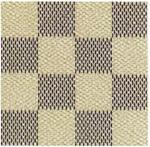Baggage claim found empty
T-275/21, Louis Vuitton Malletier v Norbert Wisniewski, General Court, 9th October 2022

Louis Vuitton failed to bag success on acquired distinctiveness, writes Stephanie Taylor
Key points
- The General Court has clarified the requirements for a finding of acquired distinctiveness in the EU, with reference to the Kit Kat decision
- Ensure that evidence filed in support of a claim of acquired distinctiveness addresses use throughout the EU as a whole and not just a substantial part of it
The General Court of the European Union (GC) has upheld the EUIPO Board of Appeal’s (BoA’s) decision to reject the evidence filed by Louis Vuitton as insufficient in relation to its claim of acquired distinctiveness in relation to its Damier Azur pattern.

In 2008, Louis Vuitton secured registration of its Damier Azur pattern as an EU designation of its International Registration covering a range of goods in class 18. In 2015, Mr Norbert Wisniewski filed an invalidity action on absolute grounds.
This was upheld by the EUIPO Cancellation Division, which held that the mark lacked distinctive character.
Louis Vuitton appealed this decision and the appeal was dismissed on the basis that the BoA found that the mark was inherently devoid of distinctive character and that Louis Vuitton had not demonstrated that the mark had acquired distinctive character through use. Louis Vuitton then appealed to the GC.
Chequered history
In its decision Louis Vuitton Malletier v EUIPO – Wisniewski (Representation of a chequerboard pattern, T‑105/19), the GC agreed with the BoA’s finding that this mark did not possess inherent distinctive character.
However, it also found that the BoA had not properly addressed the issue of whether the mark had acquired distinctive character by failing to review the evidence provided by Louis Vuitton in this regard.
Louis Vuitton had filed evidence to try and argue that the mark had acquired distinctive character through its use of the mark throughout the EU.
The case was remitted back to the Fifth Board of Appeal at the EUIPO, which determined that, after examining all the evidence submitted by Louis Vuitton, it had not demonstrated distinctive character acquired through the use of the chequerboard pattern and dismissed the action. Once again, Louis Vuitton appealed this finding to the GC.
However, because its evidence did not demonstrate that the mark had acquired distinctive character in Lithuania, Latvia, Slovakia, Slovenia and Bulgaria, the GC agreed with the BoA’s finding that the mark had not acquired distinctive character in the EU as a whole.
As background, it is accepted case law following the Kit Kat decision (Société des produits Nestlé and Others v Mondelez UK Holdings & Services, C‑84/17 P, C‑85/17 P and C‑95/17 P) that in order to demonstrate that a trade mark has acquired distinctive character, an applicant is not required to file evidence of such use in each EU Member State (ie if it can be shown that due to a geographic, cultural or linguistic proximity between two Member States, the relevant public of the first has a sufficient knowledge of the products and services that are present on the national market of the second).
In this case, while Louis Vuitton submitted a small number of invoices showing sales in these territories, these were not deemed to be sufficient, with the Court commenting:
“it is for the applicant to submit sufficient evidence to demonstrate the distinctive character acquired through use of the contested mark, including by selecting a sample of invoices representative of its activities throughout the European Union”.
Louis Vuitton had argued that it did not have stores in Estonia, Lithuania, Latvia, Slovakia, Slovenia and Bulgaria and that when assessing the overall awareness of a luxury brand by the general public, sales volume was not always proportionate to awareness.
This was on the basis that due to the marketing strategy employed by the brand, the general public may be aware of the brand even if they have not made a purchase.
Furthermore, the evidence of advertising campaigns appeared to show that Louis Vuitton had targeted other Member States and it was questionable whether customers in Estonia, Lithuania, Latvia, Slovakia, Slovenia and Bulgaria would have been exposed to these advertising materials – although given that Louis Vuitton had provided evidence of circulation in Estonia of fashion magazines that carried Louis Vuitton advertising, the Court was minded to disagree with the BoA’s findings for that single territory.
The Court did criticise the BoA’s dismissal of statements from experts on the basis that the wording of the statements was uniform – relying on the decision in Combination of the colours green and yellow, T‑137/08 – and held that “the fact that those statements are identical in content does not diminish their probative value.
Indeed, according to the case‑law, the fact that a sworn statement was made at the request of one party and that that party may have coordinated its drafting does not, in itself, undermine its content and probative value, given that, in the absence of evidence to the contrary, it must be assumed that the signatory of the statement signed it voluntarily and takes responsibility for the content thereof.”
Finally, Louis Vuitton argued that due to the geographical and cultural proximity of Latvia and Lithuania to Poland and Sweden, on the one hand, and of Bulgaria, Slovakia and Slovenia to Romania, on the other hand, the fact that the mark had been found to have acquired distinctive character in Poland, Sweden and Romania should be sufficient for a finding of distinctive character in the other territories.
However, the Court held that criteria set out in Kit Kat had not been adhered to – there was no evidence to show that customers in Latvia and Lithuania had knowledge of goods for sale in Poland and Sweden, and Bulgaria, Slovakia and Slovenia, in relation to Romania.
The Court also found that Louis Vuitton had not shown that they grouped those Member States in the same distribution network or that it had treated them, particularly in terms of its marketing strategy, as if they constituted one and the same market.
Conclusion
On balance, the Court held that the evidence provided for Estonia was sufficient to make a finding of acquired distinctiveness for this territory.
However, for the remaining States, Louis Vuitton had not met this standard and therefore had not demonstrated that the mark had acquired distinctiveness throughout the EU.





